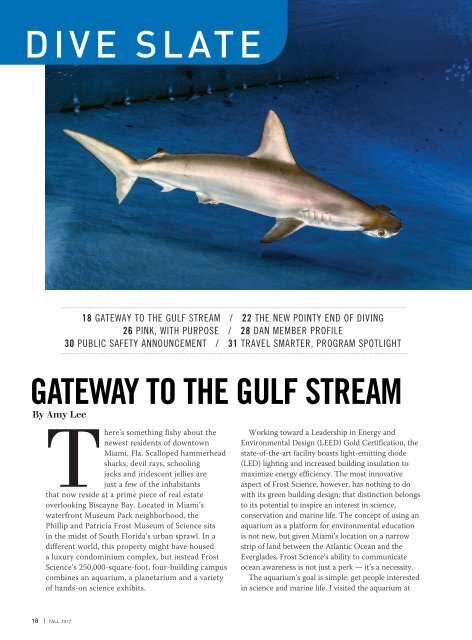AD 2017 Q4
Alert Diver is the dive industry’s leading publication. Featuring DAN’s core content of dive safety, research, education and medical information, each issue is a must-read reference, archived and shared by passionate scuba enthusiasts. In addition, Alert Diver showcases fascinating dive destinations and marine environmental topics through images from the world’s greatest underwater photographers and stories from the most experienced and eloquent dive journalists in the business.
Alert Diver is the dive industry’s leading publication. Featuring DAN’s core content of dive safety, research, education and medical information, each issue is a must-read reference, archived and shared by passionate scuba enthusiasts. In addition, Alert Diver showcases fascinating dive destinations and marine environmental topics through images from the world’s greatest underwater photographers and stories from the most experienced and eloquent dive journalists in the business.
Create successful ePaper yourself
Turn your PDF publications into a flip-book with our unique Google optimized e-Paper software.
DIVE SLATE<br />
18 GATEWAY TO THE GULF STREAM / 22 THE NEW POINTY END OF DIVING<br />
26 PINK, WITH PURPOSE / 28 DAN MEMBER PROFILE<br />
30 PUBLIC SAFETY ANNOUNCEMENT / 31 TRAVEL SMARTER, PROGRAM SPOTLIGHT<br />
GATEWAY TO THE GULF STREAM<br />
By Amy Lee<br />
There’s something fishy about the<br />
newest residents of downtown<br />
Miami, Fla. Scalloped hammerhead<br />
sharks, devil rays, schooling<br />
jacks and iridescent jellies are<br />
just a few of the inhabitants<br />
that now reside at a prime piece of real estate<br />
overlooking Biscayne Bay. Located in Miami’s<br />
waterfront Museum Park neighborhood, the<br />
Phillip and Patricia Frost Museum of Science sits<br />
in the midst of South Florida’s urban sprawl. In a<br />
different world, this property might have housed<br />
a luxury condominium complex, but instead Frost<br />
Science’s 250,000-square-foot, four-building campus<br />
combines an aquarium, a planetarium and a variety<br />
of hands-on science exhibits.<br />
Working toward a Leadership in Energy and<br />
Environmental Design (LEED) Gold Certification, the<br />
state-of-the-art facility boasts light-emitting diode<br />
(LED) lighting and increased building insulation to<br />
maximize energy efficiency. The most innovative<br />
aspect of Frost Science, however, has nothing to do<br />
with its green building design; that distinction belongs<br />
to its potential to inspire an interest in science,<br />
conservation and marine life. The concept of using an<br />
aquarium as a platform for environmental education<br />
is not new, but given Miami’s location on a narrow<br />
strip of land between the Atlantic Ocean and the<br />
Everglades, Frost Science’s ability to communicate<br />
ocean awareness is not just a perk — it’s a necessity.<br />
The aquarium’s goal is simple: get people interested<br />
in science and marine life. I visited the aquarium at<br />
18 | FALL <strong>2017</strong>









